|
Index...
|
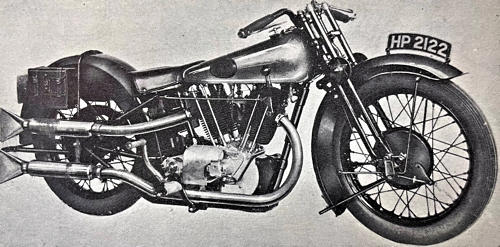
 ow hold on, before I begin, I'm not for one moment going to attempt to discredit an actual Nottingham production and claim yet another Coventry one - we have more than enough, but what I will attempt to do is set out the pre-history of the Brough Superior motorcycle, its technical evolution and the key people involved in its creation - I'll then leave it up to you to make your own mind up regarding early Brough Superior machines and how they came about, based on the following supporting evidence, suggestions, claims, and facts, so, strap yourself in....
ow hold on, before I begin, I'm not for one moment going to attempt to discredit an actual Nottingham production and claim yet another Coventry one - we have more than enough, but what I will attempt to do is set out the pre-history of the Brough Superior motorcycle, its technical evolution and the key people involved in its creation - I'll then leave it up to you to make your own mind up regarding early Brough Superior machines and how they came about, based on the following supporting evidence, suggestions, claims, and facts, so, strap yourself in....
It's right up there with some of the most iconic and sought after motors on the planet, originally labelled as the "Rolls-Royce of motorcycles" when first presented to the public in the early 20s, and later famously cemented in history when ridden by Peter O'Toole as Lawrence of Arabia in 1962. The Brough Superior is a real thing of power and beauty, and would have been the dream machine of many young kids growing up in the 1920s and 30s, and although very much a proud Nottingham product - what exactly are the true origins of this hugely desirable beast?
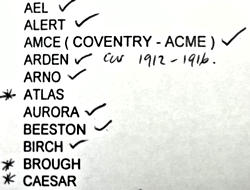
When I first began researching Coventry's motorcycle history over 20 years ago at the transport museum, there existed a scribbled list of proposed local motorcycle manufacturers that enthusiasts Ned Sparkes and Dave Barber had put together - just a maker's name and a circa date of production - no addresses, no other information at all. This was still a great starting point for me, however, and of course it featured some makes that even a novice like me had heard of. Triumph, Coventry Eagle, Francis-Barnett, Rudge, to name a few. That said, most suggested makes were totally unknown to me, except one that really stood out, called "Brough"! I'd definitely heard of the name before, but I certainly wasn't aware that there were any Coventry connections?!?
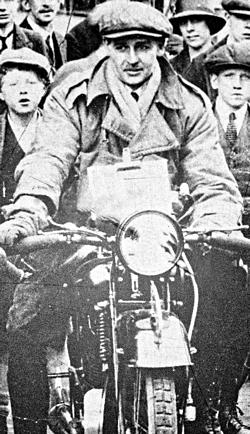
Anyway, as time moved on with my research, I simply dismissed the inclusion of Brough as an error or an exaggeration on their part. That was, until I stumbled across a VMCC magazine article on Brough of August 2005 by L. H. Nutt, in which he covered aspects of a certain Percy Mayo of the Coventry Eagle Company. Nutt revealed that Mayo was a former gun designer with the Royal Ordnance Works at Coventry, yet more interestingly, he went on to say that Mayo and George Brough were in France together, and after the war, they both worked closely on the first Brough Superior motorcycle around 1918/19. Continuing on, the article stated that Mayo was almost certainly behind the distinctive shape of the tank, and that Douglas Mayo, Percy's nephew, had given his uncle credit for the majority of the work on the first Brough Superior motorcycle!
OK, so perhaps there really was something in a Coventry link after all, but I never delved any further at the time. it was only very recently that I decided to investigate such actual claims more thoroughly, and here's how it went.
Before I completely get going though, I'm just going to provide a brief bit of background on the Brough and Mayo families.
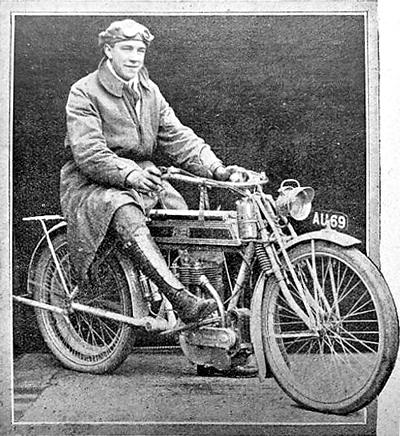
It was William Edward Brough (1861-1934) who first made his surname famous in motoring circles when in 1899 he built his first motor - a small 3.5hp De Dion powered car, and by 1902, the first Brough motor-bicycle, of which his firm at Basford, Notts, would soon concentrate their commercial attention. Sons William and George took an interest in their father's work, competing in many early trials on his machines, yet it was George (1890-1970) who would eventually take up the mantle and drive the manufacturing aspects of the business forward, and most famously resulting in the creation of the Brough Superior motorcycle. Coventry Eagle goes back further to 1890, the origins of a cycle firm called Hotchkiss, Mayo & Meek. By 1899 the firm started to build their first motors, in the shape of Royal Eagle cars and tricycles, and by the following year, motor-bicycles at a time when only one of the original founders in Edmund Mayo (b. 1854) remained. His son Arthur E. Mayo took over the management in 1913, and in 1919, his son Douglas joined the firm, followed in the early 1920s by his uncle, Percy.
So, back to the evasive Coventry links. First, I thought I'd try the transport library here at Coventry archives, and soon discovered that we did indeed possess a very relevant book - Brough Superior, the Rolls-Royce of Motorcycles by Ronald H. Clark of 1964, of which I soon discovered was researched and produced on Clark's full co-operation with George Brough himself following several interviews! On that basis, surely this book would tell me everything I needed to know about the origins of the Brough Superior and any links to Percy Mayo?
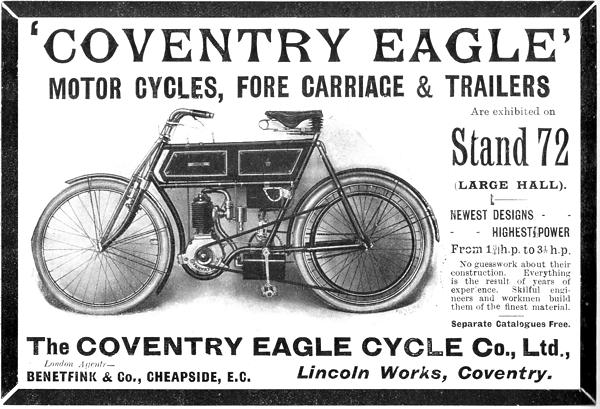
Not quite. In Chapter Two, Clark stated that during the First World War, George Brough spent 'part of this period with Messrs White & Poppe of Coventry, working on the development of aero and similar engines, and at the same time, his limited leisure permitting, designed a new flat twin motorcycle, parts of which were actually made at Vernon Road' [referring to Basford Works, Notts].
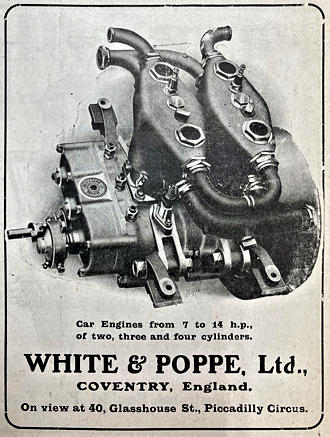
 o, straight away this was both frustrating, yet encouraging, as it was now highly evidential that Brough was not only working in Coventry in an engineering capacity, but also experimenting in designing and building his own motorcycle. However, Clark very quickly moved on to the end of the War with George joining the family business at Nottingham, and only briefly mentioned that by 1920, certain parts of the Brough Superior 'such as frames and other accessories were made in Coventry and Birmingham'. Later in the book there's the odd mention of using Montgomery forks (a Coventry firm) but then perhaps most interestingly, in Appendix A, was supplied a list of patents associated with the Brough Superior machine, one in particular standing out, a joint patent no. 126,927 by Brough and Poppe. On tracking down the actual patent on an existing website, this patent application of early 1919 from George Brough of Basford, Nottingham, and Erling Poppe of Coventry, related to 'a new and improved roller bearing for use with the crankshafts of internal combustion engines.' For clarity here, White & Poppe had been producing motor engines in Coventry from 1899, and Erling Poppe was the engineer son of one of the founders, the Dane, Peter Poppe.
o, straight away this was both frustrating, yet encouraging, as it was now highly evidential that Brough was not only working in Coventry in an engineering capacity, but also experimenting in designing and building his own motorcycle. However, Clark very quickly moved on to the end of the War with George joining the family business at Nottingham, and only briefly mentioned that by 1920, certain parts of the Brough Superior 'such as frames and other accessories were made in Coventry and Birmingham'. Later in the book there's the odd mention of using Montgomery forks (a Coventry firm) but then perhaps most interestingly, in Appendix A, was supplied a list of patents associated with the Brough Superior machine, one in particular standing out, a joint patent no. 126,927 by Brough and Poppe. On tracking down the actual patent on an existing website, this patent application of early 1919 from George Brough of Basford, Nottingham, and Erling Poppe of Coventry, related to 'a new and improved roller bearing for use with the crankshafts of internal combustion engines.' For clarity here, White & Poppe had been producing motor engines in Coventry from 1899, and Erling Poppe was the engineer son of one of the founders, the Dane, Peter Poppe.
So, in conclusion of Clark's book, although very comprehensive in terms of providing a production history of the Brough Superior, it almost appears to only provide very glancing references to George Brough's time in Coventry, when in fact clearly, as the aforementioned 1919 patent and Poppe association would heavily suggest, that far more development work was surely undertaken there? Most importantly however, why was there not one single mention of any actual War service, and/or Percy Mayo?

I then discovered there was a later book, The Brough Superior: The Complete Story by Peter Miller of 2009, and managed have the relevant pages kindly forwarded to me by Nick Jeffery. This publication went far deeper into the origins of the machine. Miller corroborated that Brough indeed went to work at White & Poppe in 1916 but went further of his time in Coventry in as much that he stated that he [Brough] bought and tested over 30 different motorcycles whilst there.
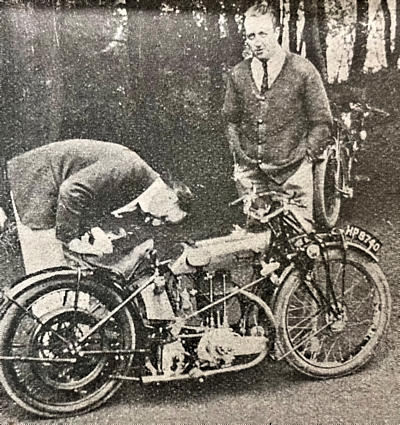
He then repeated the story that Brough met Percy Mayo in France towards the end of the War, and that together they designed the outlines of the very first Brough Superior, but also that they fell out over a business agreement. Significantly here though, he stated that 'George Brough never acknowledged the contribution made by Mayo'. Continuing 'He is not even mentioned in the semi-official history of Brough Superior by Ronald Clark'. Miller then goes on to talk about Brough's close friendship with Jack Montgomery in Coventry, stating that Brough enlisted him 'to build his new-style sporting motorcycle at the Montgomery works at Coventry', and that the very first completed machine was registered there, as HP 2122.
It was now getting really interesting at this point, yet also posed just as many questions than answers. Was Brough's very first 8hp machine seriously made and registered in Coventry? If Brough and Mayo did work together then why would Brough not acknowledge or credit any connection to him? When and where did they first meet? Did either serve in the Great War? Was there ever a formal business arrangement? Was there an actual fall out between the two? More sources were clearly needed.
Erwin Tragatsch, in his Motorcycle Encyclopedia entry on Brough, only mentioned that Montgomery of Coventry built the 1st Brough Superior frames in 1920-22. The Brough Superior Club website however stated 'He [Brough] planned and built his personal "ideal" machine while still on war work at Coventry at the end of 1914-18 war after trying out over 30 different machines. It had a thumping great vertical-valve 1,000cc JAP in a light frame. There was nothing very original about it apart from the beautiful plated saddle tank'. This was far more comprehensive, yet still no mention of Percy Mayo.
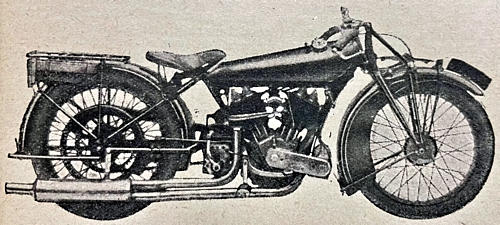
In the excellent 2010 publication, Coventry Eagle, the History of a Motorcycle Company, by John Hodson, he stated that Percy Mayo met George Brough, either in France, or more likely when Brough was working for White & Poppe in Coventry. He went on to say that after the War, Percy briefly worked for George Brough and is credited by some with much of the designing of the first Brough Superior motorcycle, adding that there were certainly many similarities between the Brough machine, and the later Coventry Eagle Flying 8. In support of this, in Bob Holliday's book 'the Motorcycle Parade' of 1974, he stated that the Coventry Eagle Flying 8 was a near-rival to the Brough Superior, both marques using 8hp Jap Engines and having impressively wide, bulbous saddle tanks.
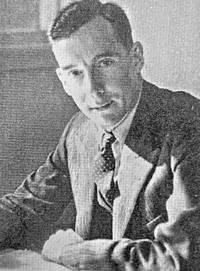
I'd just about exhausted all my secondary sources, but then by pure chance found an old cassette in the archive A.V. Room, which read in Biro 'Mr. Mayo (Coventry Eagle) interview by R. A. Brown 12/10/1982. I couldn't quite believe it! Could this be Percy Mayo revealing everything I needed to know about him and George Brough? No such luck, but instead it was a recording of his nephew Arthur Douglas Mayo (1903-1988) who worked at Coventry Eagle alongside Percy and eventually became managing director.
On listening to the tape, straight off the bat, Mayo stated that his uncle [Percy] had fallen out with George Brough. Instead, he was given a job at Coventry Eagle and would assist in building the best motorcycle they had made up to that point. It would be called the 'Flying 8' and would improve upon "all the pitfalls of the Brough Superior machine". He later mentioned that Percy, George Brough and Freddy Dixon (a once well-known rider) all mixed with one another, and also briefly mentions a place called Corley, a small hamlet Northwest of Coventry. He then categorically states that Percy was in the same regiment as George Brough, and concludes that the Coventry Eagle "cut out a lot of the thrills" of the Brough Superior.
So, the plot was certainly beginning to thicken. Was this the same recording that L. H. Nutt had listened to? Was there any truth to Brough and Mayo being in the same regiment or was this simply where the rumor had started?
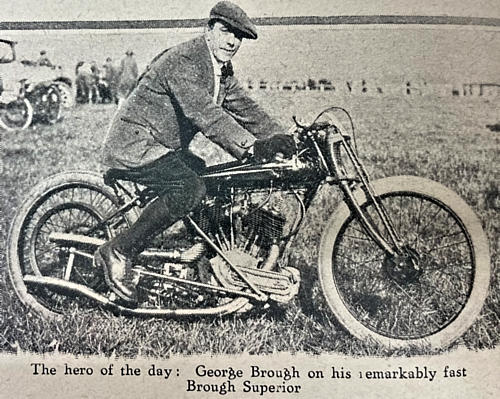
 ight then. It was time to roll up my sleeves and seek out some primary sources to try and unearth some absolute facts. The following therefore, is largely material sourced from the British Newspaper Archive, along with BMD/Census, Military Service records, and motoring journals. I will present all these findings in a timeline, focusing on the movements of George Brough, and Percy Laurence Mayo largely from just before the First World War period, and into the mid-1920s.
ight then. It was time to roll up my sleeves and seek out some primary sources to try and unearth some absolute facts. The following therefore, is largely material sourced from the British Newspaper Archive, along with BMD/Census, Military Service records, and motoring journals. I will present all these findings in a timeline, focusing on the movements of George Brough, and Percy Laurence Mayo largely from just before the First World War period, and into the mid-1920s.
1911 - The Census revealed George Brough aged 20, a 'motor engineer assistant' living at Basford, Nottinghamshire with parents William and Mabel. His father William Edward Brough (b. 1862) was listed as a 'motor engineer'. Also, Percy Mayo aged 19, a 'designer & draughtsman' living with parents and family at Barras Lane, Coventry. His father, Edmund (b. 1854) was described as a 'cycle factor'.
1913 - Percy Mayo married Mary Wheatley, and later evidence would suggest that they soon moved into a newly built house at 41 Wyley Road, in the Radford area of Coventry.
1914 - August, War declared. Most Coventry engineering firms adapted production to aid the War effort.
1915 - June, someone at 41 Wyley Road, was seen to be selling a 2hp Humber motorcycle. In the last quarter of 15, Mary Mayo, Percy's wife, gave birth to a son, Laurence.
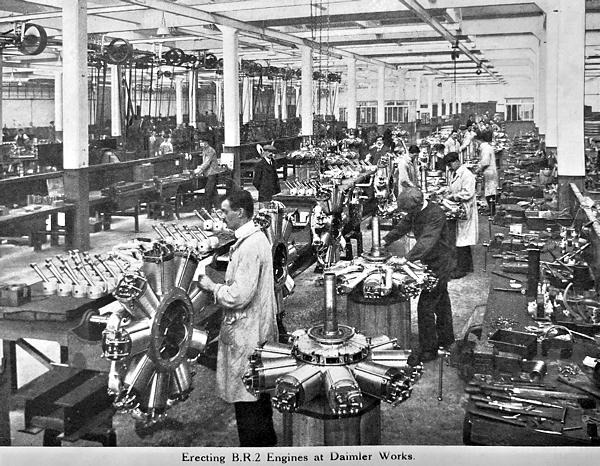
1916 - January. George Brough of Basford, Notts, was seen to be acting as the agent for 2.5ton Detroit-made Lorry's called the "Acason". June, someone at 41 Wyley Road was seen to be selling a 3.5hp Triumph, and in the same month, George Brough married Elizabeth Constance Evans at Basford, Nottinghamshire. Then, significantly, by October, as seen in the Coventry based Midland Daily Telegraph - 'married couple require bed and sitting rooms, within easy access of Daimler, state terms, board selves - Brough, 26 Coundon Road.' [NOTE] Now, all previous reports stated that Brough worked at White & Poppe in Coventry on aero-engine work, so why would he be keen to secure digs near to the Daimler? For me, this would heavily suggest that Brough initially came to Coventry after obtaining work at Daimler, who were also massively involved in war effort contracts.
By November, Brough had found new digs, as the Nottingham Evening Post published this sales notice: 'Sunbeam combination, 3.5hp with Milford sidecar, £68, George Brough, 69 Northumberland Road, Coventry'. Then in December, Brough was seen to be selling (MDT) a 1916 TT Singer motorcycle from the same address, stating 'the neatest and fastest bike in Coventry'. Very soon after, George Brough was caught up in a motoring conviction involving another rider named Stan Johnson, of whom he first lodged with at Coundon Road, and another rider named Samuel Barber. On the 30/12/16, Brough, of Northumberland Road was fined 9s for failing to keep the lights on his motorcycle properly lit whilst parked outside his lodgings. [NOTE], Northumberland Road in is the lower Coundon area of Coventry and in very close proximity to his former address at Coundon Road. Would this indicate he was still at Daimler?
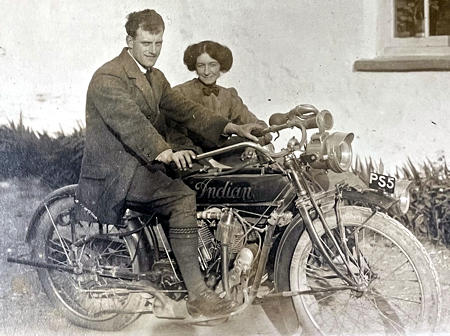
1917 - In January, Brough was seen to be selling a 1916 5hp "Indian" motorcycle from Northumberland Road, and then by February, a nearly new 10hp Morgan Grand Prix machine, but this time from an address known as "Springfield" at Corley Moor, Warwickshire. [NOTE] OK to recap a bit here, Brough is clearly buying, testing, and then selling on lots of very different types of machines, no doubt making notes about what he liked and disliked about them, as had been mentioned by others earlier. Also, in the Coventry Eagle cassette recording, Douglas Mayo briefly mentioned Corley, and now we can confirm that Brough indeed lived there. Could this have coincided with a move from Daimler to White & Poppe? I initially struggled to think of a reason why he would want to relocate to a tiny hamlet some 5.4 miles outside of Coventry, and then it suddenly dawned on me. He was a keen motorcycle engineer and tester, so by moving further out he had far greater time to experiment with his machines whilst fulfilling his main passion - riding motorbikes! On the 26th of April 1917, George's wife Elizabeth gave birth to their only child, a daughter they named Peggy, whilst at Corley Moor. In more support of the Corley links, Coventry Archives also hold photographs and press cuttings of Muriel Hind, an early female motor pioneer who resided at Wall Hill Hall, Corley. Her husband, Dick Lord (formerly of the Rex Motor Co.) stated that Brough was a famous motor cyclist who lived in a cottage nearby, and on occasion would borrow a motorcycle from him to test.
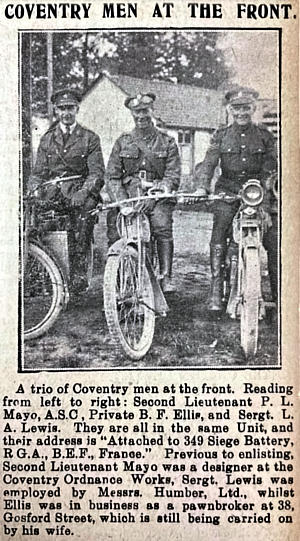
1918 - OK so this is where it began to become difficult for me to track people. In January there was a vague report of a motorcycle race between Brough and the well-known Coventry rider G. E. Stanley, but after that - I was not able to track George Brough's movements or whereabouts at all for the remainder of 1918. If he had actually joined up and gone to France, then as yet I have found zero evidence to support that. Otherwise, had he simply returned to Nottingham, or was he keeping a low profile in Coventry? Regarding Mayo, his medal card stated he joined up in March 18 as part of the Army Service Corp., and indeed by June he was pictured in the Coventry Graphic at the Western Front along with two other Coventry men astride motorcycles. By November, the War had ended.
1919 - A Patent application was made on the 15th of February 19 (126,927) by George Brough of W. E. Brough & Co., of Basford, Nottingham, and Erling Poppe [as in White & Poppe] of Warwick Avenue, Coventry, regarding 'a new or improved roller bearing for use with the crank shafts of internal combustion engines.' By March, the Nottingham Evening Post provided the following:

[NOTE] - It is important to acknowledge here that the machine described above is not the later produced and acclaimed 8hp "Brough Superior", but in fact a forerunner, a 5hp "Brough" machine. By November, W. E. Brough & Co., exhibited these 5hp new machines at Olympia, whilst the Coventry Eagle Co., did not appear. In December it was revealed that P. L. Mayo would be one of many Radford (Coventry - there's a Radford also in Notts) locals who would appear on the 'Men Who Served' memorial.
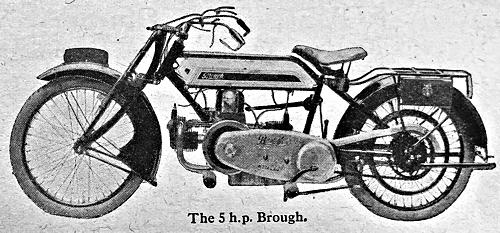
1920 - The first half of '20 became difficult to track either Brough or Mayo, but by June, Mayo began offering his services as a delivery driver/courier on his Triumph Combination from home. By July, another notice: 'trains are often inconvenient. I can take you by sidecar, terms moderate, Mayo, 41 Wyley Road', and in the same month he was also looking to offload a Rudge Multi and a BSA Combination. At Olympia in November, W. E. Brough & Co., exhibited with 3.5 and 5hp "Brough" machines, engines, and sidecars, while once again, Coventry Eagle did not feature. Then, as seen in Motor Cycling of December 22, 1920 - details of the London-Exeter Trial. Of the 160 entrants, four were to ride "Brough" machines; - Karslake, Debenham and Chidley on 5hp mounts, and Stevenson on a 3.5hp version. George Brough also entered, but significantly, on an 8hp "Brough Superior" - and this is so far my very first encounter of this famous machine ever being mentioned by name. Just purely out of interest, only one Coventry Eagle machine featured in the trial, a 6hp combination ridden by T. J. Mooney, which was for some reason later disqualified.
1921 - Wednesday January 19th, Motor Cycling, Road Tests of 1921 Models, No. 3 - The 8hp Brough Superior. A full and detailed two-page report on this very new machine, that bore the Coventry-registration HP 2122, stated "the 8hp Brough Superior made its debut in the recent London-Exeter run, and on that occasion, we particularly noticed that, whenever the machine was left for a few minutes, a large crowd inevitably gathered around it." On the very same day, as seen in the Midland Daily Telegraph, a small trade notice: 'Mechanical Drawings of all descriptions prepared, tracing, printing etc. - Mayo's Drawing Office, 41 Wyley Road, Radford, Coventry'. Perhaps just a happy coincidence?
The Midland Daily Telegraph, Thursday January 20th, 1921, under 'Machine Tools Wanted & For Sale':
For Mechanical Drawings, tracings, blueprints, etc., consult me. Recently finished layouts and working drawings, etc., for the "Brough Superior" Motorcycle - Lieut. P. L. Mayo's Drawing Office, 41 Wyley Road, Radford.

WOW! ABSOLUTE PROOF! And then just a week later, on the 28th, he went a bit further!
Do you want Designs, Drawings, Tracings, blueprints etc.? If so, we make them quickly, cheaply, and accurately. Just completed, "Brough Superior" Motorcycle.
"Motor Cycling" Jan. 19th says: "Graceful lines; general neatness. A cleverly worked-out problem." Call or write: Lieut. P. L. Mayo's Drawing Office, 41 Wyley Road. Radford.
YES!!!!
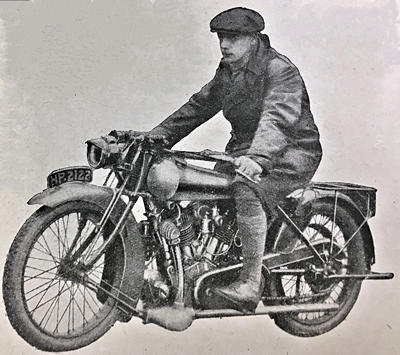
Back down to earth, regarding the situations of both as seen in the 1921 Census; George Brough was listed as a 31-year-old motorcycle manufacturer at Nottingham, living with his wife Constance, and 4-year-old daughter Peggy of "Corley Moor, Warwickshire". Meanwhile, Percy Laurence Mayo was described as a 28-year-old designer in the drawing office of the Coventry Ordnance Works at Stoney Stanton Road, however "out of work" is also written over, which probably supports the fact that he branched out independently? He was confirmed as a resident of 41 Wyley Road with wife Mary, and young son Laurence.
May 4th, notification in the Motor Cycling magazine of the Brough Superior in actual production, and on sale at a Kensington dealership. At the beginning of October during the 5th C&W Motor Club's "Manville Trophy", it was of interest to see that W. J. Montgomery competed on an 8hp Brough Superior and sidecar. At Olympia in November, George Brough of Haydn Road, Nottingham, exhibited 6.5-8hp "Brough Superior" machines for the very first time. Significantly, Coventry Eagle also exhibited, for the first time at a major exhibition in almost 20 years, offering a range of cycles, but also JAP powered motorcycles of 2.5-6hp. Presumably Percy Mayo was employed by Coventry Eagle by this time.
1922 - In February, there was a Coventry & Warwickshire Motor Club Trial starting from St. Thomas Church, Tamworth Road, Coventry. J. Watson-Bourne finished in 1st position on a Brough Superior, Percy Mayo finished 25th on a Coventry Eagle, and interestingly, Erling Poppe finished in 27th on an actual White-Poppe machine! Mayo was in fact involved in a number of trials throughout the year - the Birmingham Victory Cup in March; the London-Edinburgh run; and the Midland Centre run in July, where he won Gold on one of his Coventry Eagle machines. It was to be the London to Exeter Trial in late December though that became perhaps the most intriguing, when George Brough turned up on an 8hp Brough Superior, while Percy Mayo rolled up on an 8hp Coventry Eagle! So, how did they fare? Well, both completed the run and won gold medals in their class, but I wonder if there were any words exchanged between the two men given an earlier reported fall out? Now, I did wonder if Mayo's 8hp machine could have been a debut test run on the Coventry Eagle Flying 8, but this was far more likely to have been the 8hp Super Sports model, also designed by Percy Mayo.
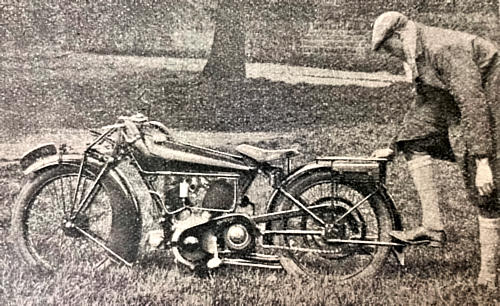
1923 - so, into the following year, the very first official report of the Coventry Eagle Flying Eight appeared in The Motor Cycling magazine on March 28th - fittingly 100 years old this very year!
'Specially tuned model with a guarantee of 80mph. To meet the demand for a specially tuned super sports machine, The Coventry Eagle Cycle & Motor Co have introduced a new edition of their JAP engine sports model, which is to be known as the Flying 8, and will be sold with a guarantee of 80mph. The specification, apart from the engine, is similar to the standard sports model, with the exception of the silencing system. The exhaust gases are led into a large, attractive-looking expansion chamber lying along the rear chain stays, the end of which is closed by a removable dished plate with a single short outlet pipe. Inside the expansion chamber is a cage carrying a set of baffle plates, which effectively silence the exhaust, but which may be removed with the end plate for hill climbs or speed events. The price is £140, at which the new model is excellent value for a high-class super-sports mount with a guaranteed performance.'
By May, Montgomery & Co., revealed their new Montgomery Sports machine in time for the Sidecar TT, and by September W. J. Montgomery himself was selling his Brough Superior that he had used "in winning numerous gold medals and premier awards in speed and long-distance reliability trials - £75, or with sidecar £90, can be seen at the works of W. Montgomery & Co., Leicester Causeway, Coventry'. At Olympia in October, George Brough of Haydn Road, Notts exhibited on stand 34 with a modified "S.S.80" Brough Superior model, and also a Brough Superior Mark II, 6.5hp. Also W. Montgomery & Co., on stand 85 with a range of 10 sidecars, but also a range of 5 "Montgomery" motorcycles, from 150cc to 600cc. Meanwhile, the Coventry Eagle Cycle & Motor Co., of St. Patrick's Road, Coventry exhibited at stand 117 with a range of 9 cycles, and 7 motorcycles from 293cc all the way up to their 8hp "Sports" and "Flying-8" models.
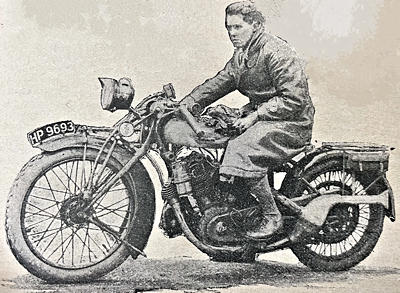
1924 - in February, W. Montgomery & Co., officially released their "Montgomery-Anzani" 8hp machine, and the following blurb adds really good weight to their previous involvement in the development of the Brough Superior -
'It may not be generally known that this firm has specialized in big twin construction for some time past, and has played a most active part in the earlier stages of production of some of the most famous British powerful two-cylinder motorcycles which have so successfully challenged similar American machines.'
By July, P. L. Mayo of "The Bungalow", Corley Moor, was seen to be selling a Morgan, and you may recall that a few years earlier, George Brough also resided at Corley Moor. At Olympia in November, Coventry Eagle appeared at stand 70, with a range of five motorcycles - the model S102 "Flying-Eight"; the S98 "Flying-Eight"; the C98 "Flying-Eight" combination; the S35 and S35X 350cc; and three versions of the S28. They also exhibited a range of cycles. George Brough of Haydn Road Notts, also appeared offering the "S.S.80" and "S.S.100" motorcycles on stand 35. W. Montgomery & Co., exhibited too, with a range of 5 motorcycles from their top of the range 8/35hp Anzani sports to 175cc lightweights, and also a range of sidecars.
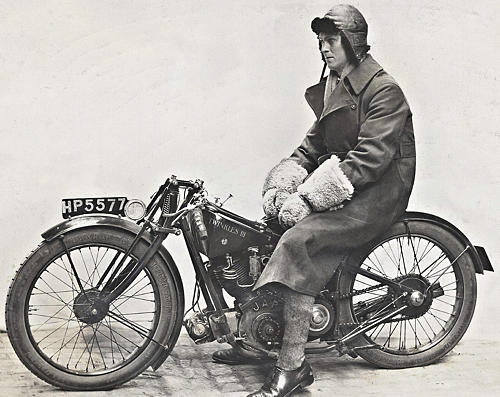
 ow, I could continue in this vein, but I won't, as I believe I have provided ample evidence up to this point that proves beyond any reasonable doubt that the Brough Superior was both conceived and developed in Coventry, whilst having confirmed and undisputed ties to the likes of Erling Poppe, William John Montgomery, and perhaps most significantly, its designer, Percy Laurence Mayo.
ow, I could continue in this vein, but I won't, as I believe I have provided ample evidence up to this point that proves beyond any reasonable doubt that the Brough Superior was both conceived and developed in Coventry, whilst having confirmed and undisputed ties to the likes of Erling Poppe, William John Montgomery, and perhaps most significantly, its designer, Percy Laurence Mayo.
So, what ultimately became of these key people? Well, in 1922 Erling Poppe joined forces with Gilmour Packman to create the Coventry motorcycle firm of Packman & Poppe producing "P. &. P" models. Packman was actually killed in a fight at the Earlsdon factory in 1925, and the firm didn't last much longer. Poppe went on to work for Rover in Coventry and then Dennis Bros. Following WW2 he worked at Sunbeam, designing the S7 motorcycle, and in 1954 designed the Gordon 3-wheeler! He died at Knaphill, Surrey in 1970.
Montgomery, known to his friends as "Jack", sadly lost his young wife Doris in 1924 to pneumonia, but remarried six years later. As early pioneer sidecar makers from 1902, his sidecar and motorcycle manufacturing firm lasted until around 1931, when he then set up a new firm called Montgomery Motors at Walsgrave Road selling second hand vehicles until about 1942. He also dabbled as an electrical engineer, but later became a manufacturers agent. He died at Nuneaton in 1982.
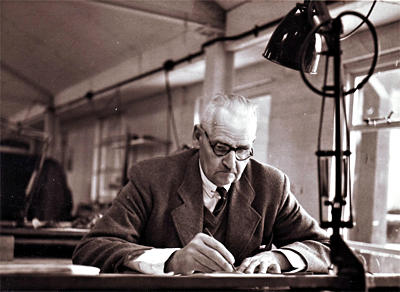
Percy Mayo continued working for the family business, Coventry eagle, as a designer, and became something of a pioneer in pressed steel framework. In 1933 he lost his only son, Laurence, aged 18, and this may have had an impact on his working life, as by 1939 he and his wife Mary were listed as cafe proprietors at 5 Radford Road. He did eventually find his way back into design engineering, and died at Weymouth, Dorset in 1972.
And as for George Brough himself? Well, his motorcycle business went from strength to strength, and he never really stopped in his quest to further improve his machines. He briefly dipped into car production in the 1930s, and during WW2 his works became devoted to sub-contracts for Rolls-Royce Merlin engines which powered the Hurricane, Spitfire, Mosquito and Lancaster. He was an admirer of Jaguar cars and in February 1962 he registered his gun metal grey E-Type "GB 1001". He had been ill for a few weeks prior to his death in January 1970 yet had been active in the business up to that time.
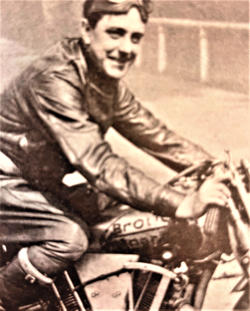
So, there we have it - I can't really add any more evidence to this research, but there are still many questions that remain unanswered. The greatest mystery for me, is whether or not George Brough actually saw any military service, but up to now I have seen no proof to back this up. If he did, then I would have thought that it would surely have been with the Royal Army Service Corp of which Percy Mayo, Jack Montgomery and Erling Poppe were known to be part of? If there's anyone out there that can add any more information to this then I would be only too glad to hear it.
And just when and where exactly did Brough and Mayo meet? The earliest record I have of Brough in Coventry was October 1916, and I believe Mayo joined the A.S.C. in March 1918. War ended in November 1918, but whether Mayo was discharged at that point or remained in some capacity I'm not certain. On that basis then one would have to conclude that Brough and Mayo met in Coventry between October 1916 and February/March 1918 - surely enough time to form a friendship and combine engineering talents and ideas? Did Mayo then later spend some time up in Nottingham during 1919/20? It's not even inconceivable that both had met prior to 1916 in their shared interest in motorcycling at a time trial or endurance event.
Ultimately though, did George Brough actually serve in France during WW1 or is this just a handed down misinterpretation? As yet we cannot say for certain, but quite Ironically, his motorcycle legacy does live on in that very country at this precise moment! Back in 2013 a factory was set up near Toulouse, where a full range of modern Brough Superior French engineered machines are still being designed and produced, so one way or another, it appears that George did make it to France after all.
Damien Kimberley, August 2023
Website by Rob Orland © 2002 to 2024